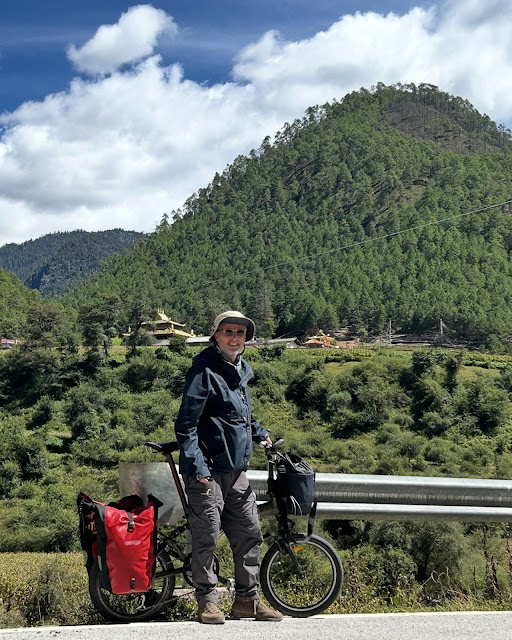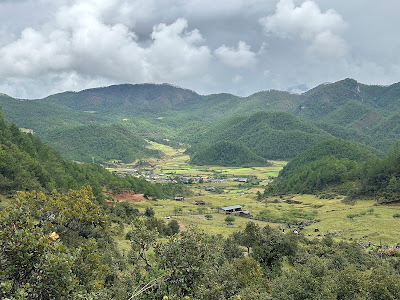As part of my recent return to Muli trip we made a visit to the wonderful Waerdje monastery in the north of the Muli valley, about 60km from Wachang.
I'd never been to Waerdje before, but had been tantalised by Joseph Rock's description of it high in the valley above the Litang river, one of the three palaces of the Muli king. Until recently the only images I'd seen of Waerdje were those taken a decade ago by a birdwatching couple - John and Jemi - from Hong Kong. At that time the monastery looked only partially restored, and rather bleak.
So I was excited when my academic colleagues Zhu Dan and Wang Liang took me on a day trip to see Waerdje from Wachang by jeep. The first half of the day was spent visiting another local sightseeing spot - Mana Chajing Viewing Platform (玛娜茶金观景台), which has a great view of the three peaks of Yading.
To get to this spot we drove north up the river for about 30km to Guzheng, then turned uphill on the G227 ascending steeply into forest via some switchbacks until we reached a kind of 'Little Switzerland' plateau of forest and pastures called Longsa. The road turned north again and eventually goes all the way over to the Shuiluo river valley.
We turned off near the top and headed out to the edge of the plateau facing west, to get occasional glimpses of the three sacred peaks. The newly-completed road was excellent all the way, and we barely saw another soul - just one other car containing some local Tibetans at Mana Chajing.
At lunchtime we retraced our route back down to the Litang river valley at Guzheng, then turned north and drove further up the valley, almost to Chabulang. The valley was very green and fertile in September, but also quite hot - in contrast to the icy winds we'd experienced up at Man Chajing. There were quite a lot of hydro power dam works along the Litang river too.
After a brief lunch stop for some instant noodles and sausage at Shawan (and an impromptu game of snooker on a terrible table, I lost) we crossed the Litang river on a small bridge to the east side and began another switchback ascent up a minor road through Tibetan farm country. After about 30 minutes we arrived at the gates of Waerdje monastery (瓦尔寨大寺 Waerzhai Dasi).
Parking the car near some prayer flags, we found about four monks in a simple kitchen and introduced ourselves. Wang Liang had been here before for some weeks, as had Zhu Dan, so they were familiar with the place and friendly with the monks.
First we had a walk around the grounds of the two temples, located in an idyllic part of the valley, surrounded by rustling trees and singing birds. How do Buddhists manage to find such magic locations? One of the monks showed us the ruins of the old temple and palace that had existed during Rock's time and been destroyed during the Tibetan rebellion of the late 1950s.
The temples have been extensively rebuilt. A sign said the full official name of the Gelugpa sect temple was Lading Ganden Dajilin and it is sited at 2800m altitude. It was established in 1584 by Choje and Songji Gyatso, the first living Buddha of Muli, appointed by the Third Dalai Lama. modelled after the Ganden monastery in Lhasa, it is centred around a Sakyamuni Buddha Hall and an Awakening Buddha statue.
In its heyday it had 330 resident monks, but now only eleven. Tibetan Buddhist monasteries now only allow monks over the age of 18 to study for the monkhood. It was rebuilt after its destruction starting in 1988 and now features a Suowukang Hall, Cuoqin Hall and a pagoda (the sign says).
The official sign also said the monastery had been restored as a centre of Buddhist learning, teaching the three disciplines of precepts, concentration and wisdom. Having said that, a large slogan at the entrance read: "Support Chinese national (ie sinicised) Tibetan Buddhism teaching direction."
Same location as photo above:
I also some spent some time in the kitchen/dining room with the monks, showing them my old photos of the monks at Muli monastery, and some of them spotted their younger selves, which raised a few laughs.
At around 5pm we called it a day. The monks insisted on giving us a formal farewell with a presentation of kata white scarves and some apples from their trees.
Waerdje definitely is a special place with that serene, forgotten vibe of times gone by that used to exist at Muli before it was developed into a massive modern temple complex. I'd love to go back and spend a bit more time there, just hanging out.
Not much more to say than to post a few photos and maps.



.JPG)





























.jpg)










.PNG)














.png)
.png)


